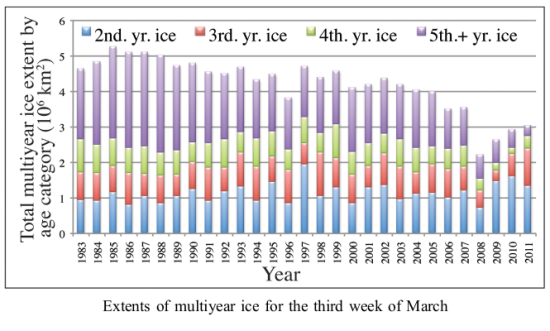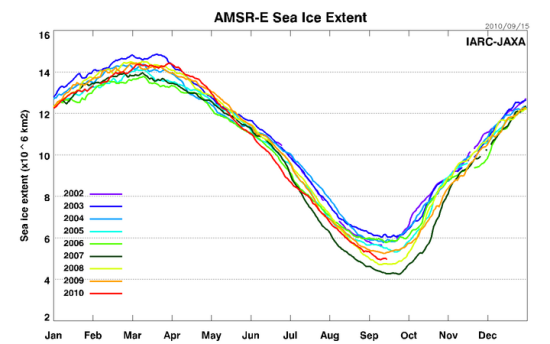Two new studies say different things about Greenland’s icecap history
The uncertainty of science: Two new studies of Greenland’s icecap suggest completely opposite histories, with one saying that Greenland was ice free at least once in the past 2.6 million years, with the other saying that the icecap covered Greenland continuously for the past 7.5 million years.
Evidence buried in Greenland’s bedrock shows the island’s massive ice sheet melted nearly completely at least once in the last 2.6 million years. This suggests that Greenland’s ice may be less stable than previously believed. “Our study puts Greenland back on the endangered ice-sheet map,” says Joerg Schaefer, a palaeoclimatologist at the Lamont-Doherty Earth Observatory in Palisades, New York, and co-author of a paper published on 7 December in Nature.
A second paper in the same issue paints a slightly different view of the ice sheet’s past stability. A group led by Paul Bierman, a geomorphologist at the University of Vermont in Burlington, found that ice covered eastern Greenland for all of the past 7.5 million years. Experts say the two papers do not necessarily contradict one another: at times, nearly all of Greenland’s ice could have melted (as seen by Schaefer’s team) while a frosty cap remained in the eastern highlands (as seen by Bierman’s group).
If all of Greenland’s ice melted, it would raise sea levels by seven metres. Models suggest that Greenland could become ice-free as soon as 2,500 years from now, depending on the concentration of greenhouse gases in the atmosphere. [emphasis mine]
This story is a perfect example of how the passionate belief in a theory (that global warming is happening, is a threat, and will melt the icecaps) can warp a scientist’s thinking. Both studies used a single drilled ice core, with the first from Greenland’s central region and the second from Greenland’s eastern region. Thus, there is no reason to say that the entire Greenland icecap had melted, as noted in the highlighted text that describes the first study. What the data merely suggests is that these two regions might have had different histories.
Instead, the article, in its effort to confirm the possibility that Greenland’s icecap could melt entirely and thus pose a threat of a big sea level rise, ignores this simple detail and struggles to justify the concept that the entire cap certainly melted in the past, even though one study suggests otherwise. This causes everyone to misunderstand the results, and draw conclusions that are uncalled for, based on the available data.
The uncertainty of science: Two new studies of Greenland’s icecap suggest completely opposite histories, with one saying that Greenland was ice free at least once in the past 2.6 million years, with the other saying that the icecap covered Greenland continuously for the past 7.5 million years.
Evidence buried in Greenland’s bedrock shows the island’s massive ice sheet melted nearly completely at least once in the last 2.6 million years. This suggests that Greenland’s ice may be less stable than previously believed. “Our study puts Greenland back on the endangered ice-sheet map,” says Joerg Schaefer, a palaeoclimatologist at the Lamont-Doherty Earth Observatory in Palisades, New York, and co-author of a paper published on 7 December in Nature.
A second paper in the same issue paints a slightly different view of the ice sheet’s past stability. A group led by Paul Bierman, a geomorphologist at the University of Vermont in Burlington, found that ice covered eastern Greenland for all of the past 7.5 million years. Experts say the two papers do not necessarily contradict one another: at times, nearly all of Greenland’s ice could have melted (as seen by Schaefer’s team) while a frosty cap remained in the eastern highlands (as seen by Bierman’s group).
If all of Greenland’s ice melted, it would raise sea levels by seven metres. Models suggest that Greenland could become ice-free as soon as 2,500 years from now, depending on the concentration of greenhouse gases in the atmosphere. [emphasis mine]
This story is a perfect example of how the passionate belief in a theory (that global warming is happening, is a threat, and will melt the icecaps) can warp a scientist’s thinking. Both studies used a single drilled ice core, with the first from Greenland’s central region and the second from Greenland’s eastern region. Thus, there is no reason to say that the entire Greenland icecap had melted, as noted in the highlighted text that describes the first study. What the data merely suggests is that these two regions might have had different histories.
Instead, the article, in its effort to confirm the possibility that Greenland’s icecap could melt entirely and thus pose a threat of a big sea level rise, ignores this simple detail and struggles to justify the concept that the entire cap certainly melted in the past, even though one study suggests otherwise. This causes everyone to misunderstand the results, and draw conclusions that are uncalled for, based on the available data.


